Chen He
What Makes Reasoning Invalid: Echo Reflection Mitigation for Large Language Models
Nov 09, 2025Abstract:Large Language Models (LLMs) have demonstrated remarkable performance across a wide range of reasoning tasks. Recent methods have further improved LLM performance in complex mathematical reasoning. However, when extending these methods beyond the domain of mathematical reasoning to tasks involving complex domain-specific knowledge, we observe a consistent failure of LLMs to generate novel insights during the reflection stage. Instead of conducting genuine cognitive refinement, the model tends to mechanically reiterate earlier reasoning steps without introducing new information or perspectives, a phenomenon referred to as "Echo Reflection". We attribute this behavior to two key defects: (1) Uncontrollable information flow during response generation, which allows premature intermediate thoughts to propagate unchecked and distort final decisions; (2) Insufficient exploration of internal knowledge during reflection, leading to repeating earlier findings rather than generating new cognitive insights. Building on these findings, we proposed a novel reinforcement learning method termed Adaptive Entropy Policy Optimization (AEPO). Specifically, the AEPO framework consists of two major components: (1) Reflection-aware Information Filtration, which quantifies the cognitive information flow and prevents the final answer from being affected by earlier bad cognitive information; (2) Adaptive-Entropy Optimization, which dynamically balances exploration and exploitation across different reasoning stages, promoting both reflective diversity and answer correctness. Extensive experiments demonstrate that AEPO consistently achieves state-of-the-art performance over mainstream reinforcement learning baselines across diverse benchmarks.
MoCHA: Advanced Vision-Language Reasoning with MoE Connector and Hierarchical Group Attention
Jul 30, 2025Abstract:Vision large language models (VLLMs) are focusing primarily on handling complex and fine-grained visual information by incorporating advanced vision encoders and scaling up visual models. However, these approaches face high training and inference costs, as well as challenges in extracting visual details, effectively bridging across modalities. In this work, we propose a novel visual framework, MoCHA, to address these issues. Our framework integrates four vision backbones (i.e., CLIP, SigLIP, DINOv2 and ConvNeXt) to extract complementary visual features and is equipped with a sparse Mixture of Experts Connectors (MoECs) module to dynamically select experts tailored to different visual dimensions. To mitigate redundant or insufficient use of the visual information encoded by the MoECs module, we further design a Hierarchical Group Attention (HGA) with intra- and inter-group operations and an adaptive gating strategy for encoded visual features. We train MoCHA on two mainstream LLMs (e.g., Phi2-2.7B and Vicuna-7B) and evaluate their performance across various benchmarks. Notably, MoCHA outperforms state-of-the-art open-weight models on various tasks. For example, compared to CuMo (Mistral-7B), our MoCHA (Phi2-2.7B) presents outstanding abilities to mitigate hallucination by showing improvements of 3.25% in POPE and to follow visual instructions by raising 153 points on MME. Finally, ablation studies further confirm the effectiveness and robustness of the proposed MoECs and HGA in improving the overall performance of MoCHA.
ORB-SLAM3AB: Augmenting ORB-SLAM3 to Counteract Bumps with Optical Flow Inter-frame Matching
Nov 27, 2024Abstract:This paper proposes an enhancement to the ORB-SLAM3 algorithm, tailored for applications on rugged road surfaces. Our improved algorithm adeptly combines feature point matching with optical flow methods, capitalizing on the high robustness of optical flow in complex terrains and the high precision of feature points on smooth surfaces. By refining the inter-frame matching logic of ORB-SLAM3, we have addressed the issue of frame matching loss on uneven roads. To prevent a decrease in accuracy, an adaptive matching mechanism has been incorporated, which increases the reliance on optical flow points during periods of high vibration, thereby effectively maintaining SLAM precision. Furthermore, due to the scarcity of multi-sensor datasets suitable for environments with bumpy roads or speed bumps, we have collected LiDAR and camera data from such settings. Our enhanced algorithm, ORB-SLAM3AB, was then benchmarked against several advanced open-source SLAM algorithms that rely solely on laser or visual data. Through the analysis of Absolute Trajectory Error (ATE) and Relative Pose Error (RPE) metrics, our results demonstrate that ORB-SLAM3AB achieves superior robustness and accuracy on rugged road surfaces.
DIDLM:A Comprehensive Multi-Sensor Dataset with Infrared Cameras, Depth Cameras, LiDAR, and 4D Millimeter-Wave Radar in Challenging Scenarios for 3D Mapping
Apr 15, 2024Abstract:This study presents a comprehensive multi-sensor dataset designed for 3D mapping in challenging indoor and outdoor environments. The dataset comprises data from infrared cameras, depth cameras, LiDAR, and 4D millimeter-wave radar, facilitating exploration of advanced perception and mapping techniques. Integration of diverse sensor data enhances perceptual capabilities in extreme conditions such as rain, snow, and uneven road surfaces. The dataset also includes interactive robot data at different speeds indoors and outdoors, providing a realistic background environment. Slam comparisons between similar routes are conducted, analyzing the influence of different complex scenes on various sensors. Various SLAM algorithms are employed to process the dataset, revealing performance differences among algorithms in different scenarios. In summary, this dataset addresses the problem of data scarcity in special environments, fostering the development of perception and mapping algorithms for extreme conditions. Leveraging multi-sensor data including infrared, depth cameras, LiDAR, 4D millimeter-wave radar, and robot interactions, the dataset advances intelligent mapping and perception capabilities.Our dataset is available at https://github.com/GongWeiSheng/DIDLM.
Optimal Time of Arrival Estimation for MIMO Backscatter Channels
Nov 22, 2023Abstract:In this paper, we propose a novel time of arrival (TOA) estimator for multiple-input-multiple-output (MIMO) backscatter channels in closed form. The proposed estimator refines the estimation precision from the topological structure of the MIMO backscatter channels, and can considerably enhance the estimation accuracy. Particularly, we show that for the general $M \times N$ bistatic topology, the mean square error (MSE) is $\frac{M+N-1}{MN}\sigma^2_0$, and for the general $M \times M$ monostatic topology, it is $\frac{2M-1}{M^2}\sigma^2_0$ for the diagonal subchannels, and $\frac{M-1}{M^2}\sigma^2_0$ for the off-diagonal subchannels, where $\sigma^2_0$ is the MSE of the conventional least square estimator. In addition, we derive the Cramer-Rao lower bound (CRLB) for MIMO backscatter TOA estimation which indicates that the proposed estimator is optimal. Simulation results verify that the proposed TOA estimator can considerably improve both estimation and positioning accuracy, especially when the MIMO scale is large.
Joint Precoding for Active Intelligent Transmitting Surface Empowered Outdoor-to-Indoor Communication in mmWave Cellular Networks
Jun 28, 2022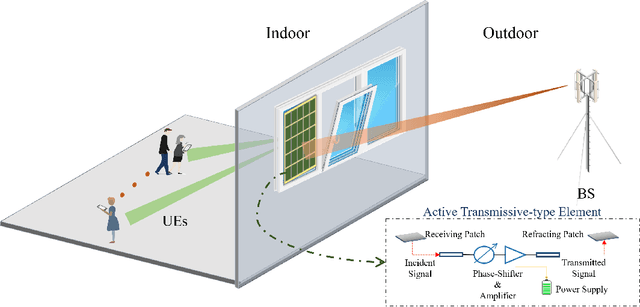
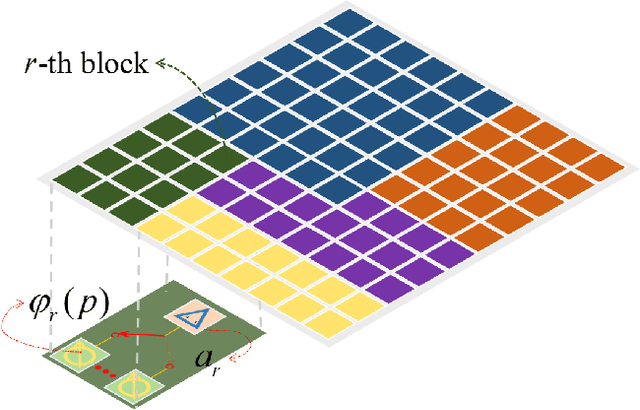
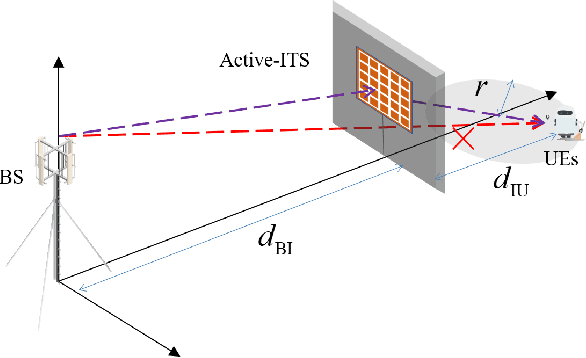
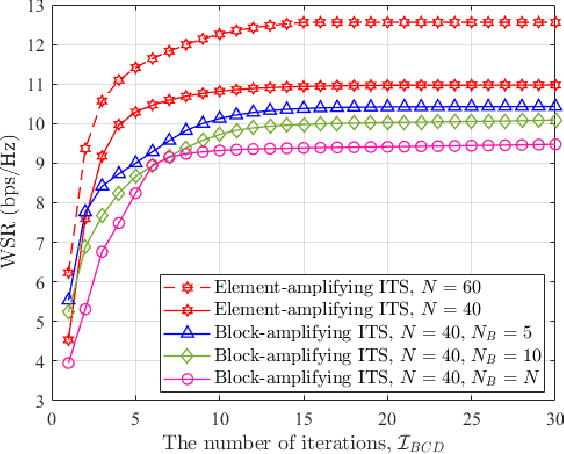
Abstract:Outdoor-to-indoor communications in millimeter-wave (mmWave) cellular networks have been one challenging research problem due to the severe attenuation and the high penetration loss caused by the propagation characteristics of mmWave signals. We propose a viable solution to implement the outdoor-to-indoor mmWave communication system with the aid of an active intelligent transmitting surface (active-ITS), where the active-ITS allows the incoming signal from an outdoor base station (BS) to pass through the surface and be received by the indoor user-equipments (UEs) after shifting its phase and magnifying its amplitude. Then, the problem of joint precoding of the BS and active-ITS is investigated to maximize the weighted sum-rate (WSR) of the communication system. An efficient block coordinate descent (BCD) based algorithm is developed to solve it with the suboptimal solutions in nearly closed-forms. In addition, to reduce the size and hardware cost of an active-ITS, we provide a block-amplifying architecture to partially remove the circuit components for power-amplifying, where multiple transmissive-type elements (TEs) in each block share a same power amplifier. Simulations indicate that active-ITS has the potential of achieving a given performance with much fewer TEs compared to the passive-ITS under the same total system power consumption, which makes it suitable for application to the size-limited and aesthetic-needed scenario, and the inevitable performance degradation caused by the block-amplifying architecture is acceptable.
Robust Joint Design for Intelligent Reflecting Surfaces Assisted Cell-Free Networks
Jan 24, 2022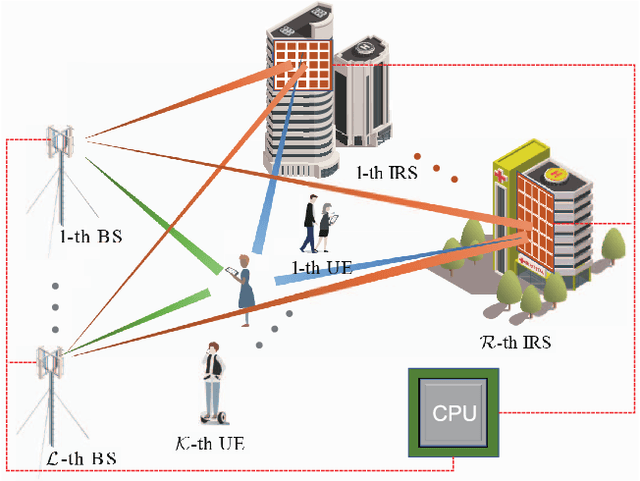
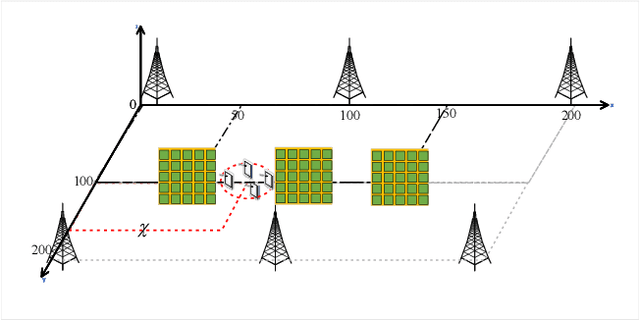
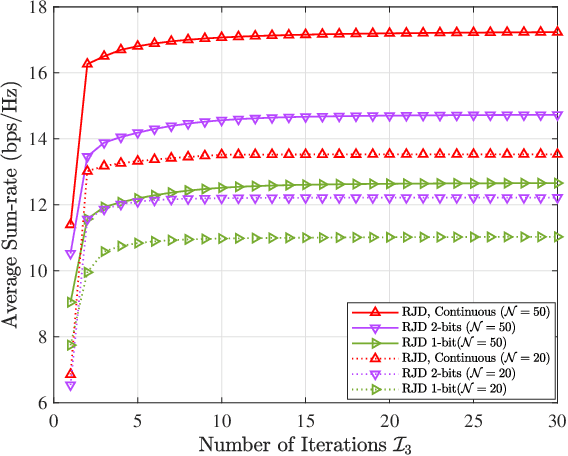
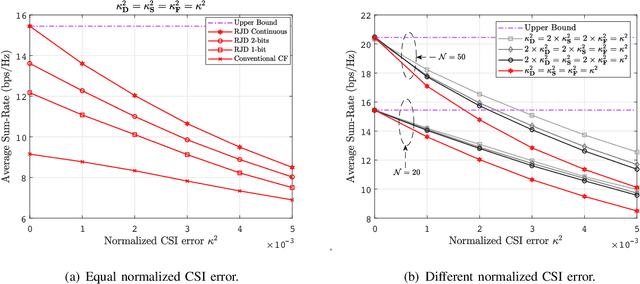
Abstract:Intelligent reflecting surfaces (IRSs) have emerged as a promising economical solution to implement cell-free networks. However, the performance gains achieved by IRSs critically depend on smartly tuned passive beamforming based on the assumption that the accurate channel state information (CSI) knowledge is available at the central processing unit (CPU), which is practically impossible. Thus, in this paper, we investigate the impact of the CSI uncertainty on IRS-assisted cell-free networks. We adopt a stochastic method to cope with the CSI uncertainty by maximizing the expectation of the sum-rate, which guarantees the robust performance over the average. Accordingly, an average sum-rate maximization problem is formulated, which is non-convex and arduous to obtain its optimal solution due to the coupled variables and the expectation operation with respect to CSI uncertainties. As a compromising approach, we develop an efficient robust joint design algorithm with low-complexity. Particularly, the original problem is equivalently transformed into a tractable form by employing algebraic manipulations. Then, the locally optimal solution can be obtained iteratively. We further prove that the CSI uncertainty has no direct impact on the optimizing of the passive reflecting beamforming. It is worth noting that the investigated scenario is flexible and general in communications, thus the proposed algorithm can act as a general framework to solve various sum-rate maximization problems. Simulation results demonstrate that IRSs can achieve considerable data rate improvement for conventional cell-free networks, and confirm the resilience of the proposed algorithm against the CSI uncertainty.
A Joint Power Splitting, Active and Passive Beamforming Optimization Framework for IRS Assisted MIMO SWIPT System
May 30, 2021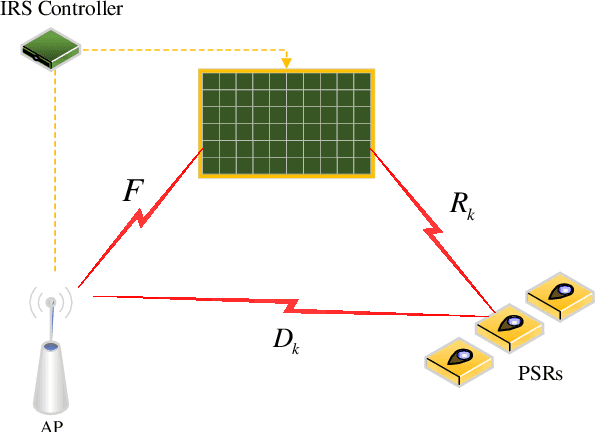
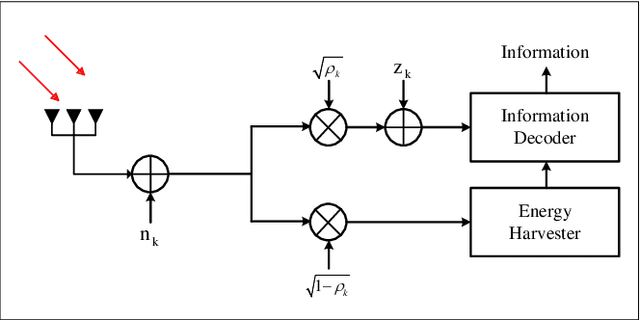
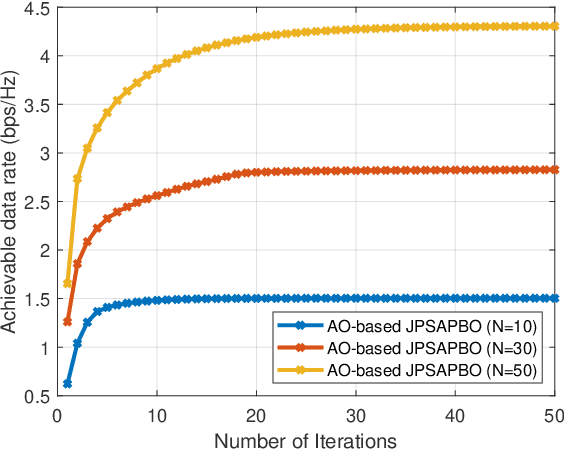
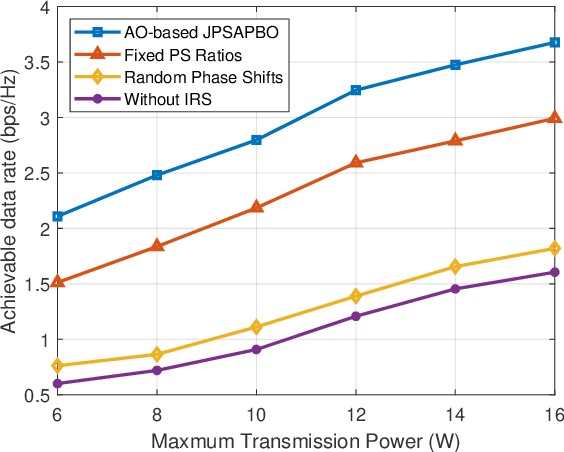
Abstract:This paper considers an intelligent reflecting surface (IRS) assisted multi-input multi-output (MIMO) power splitting (PS) based simultaneous wireless information and power transfer (SWIPT) system with multiple PS receivers (PSRs). The objective is to maximize the achievable data rate of the system by jointly optimizing the PS ratios at the PSRs, the active transmit beamforming (ATB) at the access point (AP), and the passive reflective beamforming (PRB) at the IRS, while the constraints on maximum transmission power at the AP, the reflective phase shift of each element at the IRS, the individual minimum harvested energy requirement of each PSR, and the domain of PS ratio of each PSR are all satisfied. For this unsolved problem, however, since the optimization variables are intricately coupled and the constraints are conflicting, the formulated problem is non-convex, and cannot be addressed by employing exist approaches directly. To this end, we propose a joint optimization framework to solve this problem. Particularly, we reformulate it as an equivalent form by employing the Lagrangian dual transform and the fractional programming transform, and decompose the transformed problem into several sub-problems. Then, we propose an alternate optimization algorithm by capitalizing on the dual sub-gradient method, the successive convex approximation method, and the penalty-based majorization-minimization approach, to solve the sub-problems iteratively, and obtain the optimal solutions in nearly closed-forms. Numerical simulation results verify the effectiveness of the IRS in SWIPT system and indicate that the proposed algorithm offers a substantial performance gain.
A Deep Learning Based Attack for The Chaos-based Image Encryption
Jul 29, 2019
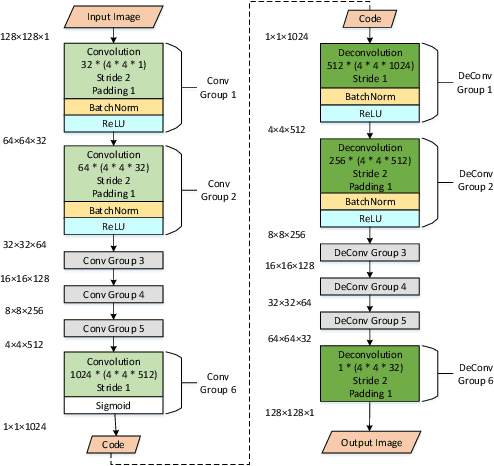


Abstract:In this letter, as a proof of concept, we propose a deep learning-based approach to attack the chaos-based image encryption algorithm in \cite{guan2005chaos}. The proposed method first projects the chaos-based encrypted images into the low-dimensional feature space, where essential information of plain images has been largely preserved. With the low-dimensional features, a deconvolutional generator is utilized to regenerate perceptually similar decrypted images to approximate the plain images in the high-dimensional space. Compared with conventional image encryption attack algorithms, the proposed method does not require to manually analyze and infer keys in a time-consuming way. Instead, we directly attack the chaos-based encryption algorithms in a key-independent manner. Moreover, the proposed method can be trained end-to-end. Given the chaos-based encrypted images, a well-trained decryption model is able to automatically reconstruct plain images with high fidelity. In the experiments, we successfully attack the chaos-based algorithm \cite{guan2005chaos} and the decrypted images are visually similar to their ground truth plain images. Experimental results on both static-key and dynamic-key scenarios verify the efficacy of the proposed method.
Average Entropy Functions
Apr 13, 2009Abstract:The closure of the set of entropy functions associated with n discrete variables, Gammar*n, is a convex cone in (2n-1)- dimensional space, but its full characterization remains an open problem. In this paper, we map Gammar*n to an n-dimensional region Phi*n by averaging the joint entropies with the same number of variables, and show that the simpler Phi*n can be characterized solely by the Shannon-type information inequalities
 Add to Chrome
Add to Chrome Add to Firefox
Add to Firefox Add to Edge
Add to Edge